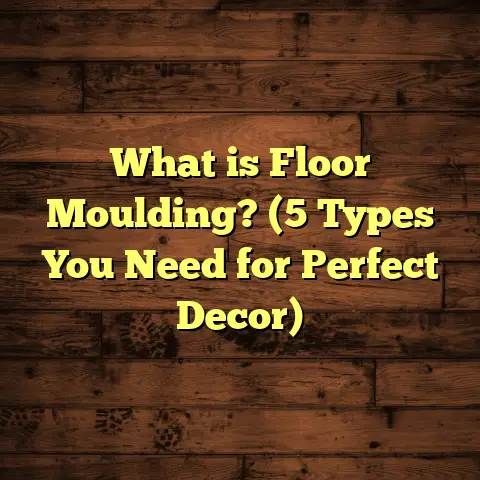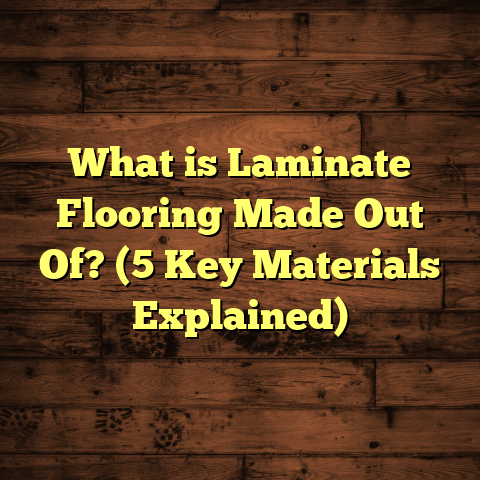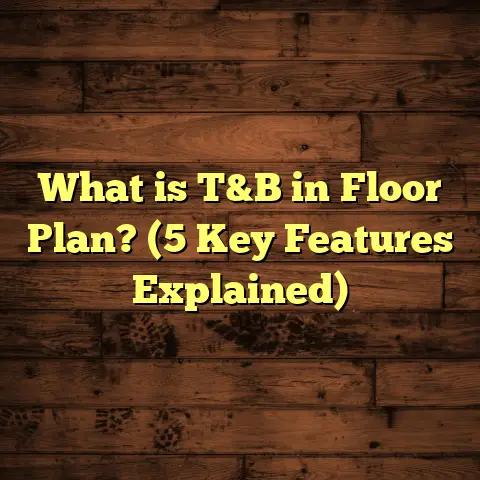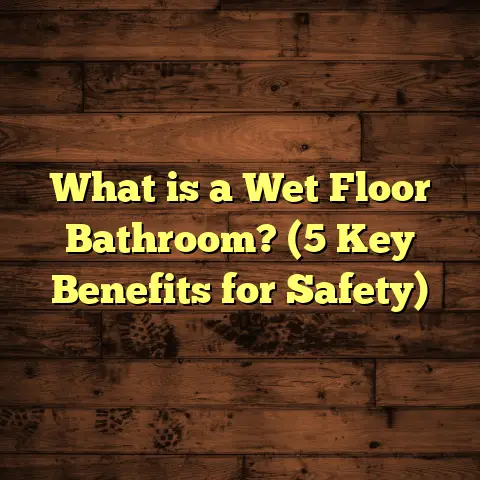What is Cheaper: Wood Flooring or Carpet? (5 Cost Factors Revealed)
Have you ever thought about how much your choice of flooring says about the vibe you want in your home? Some people are all about that warm, natural look of wood floors. Others swear by the cozy, cushy feel of carpet beneath their feet. I get asked a lot—especially by friends, clients, and folks who want to redo their homes—“Which one is cheaper, wood flooring or carpet?”
It’s a question that sounds simple but actually has many layers. I’ve been working as a flooring contractor for over 15 years, and in that time, I’ve seen plenty of homes with both carpet and wood floors. I’ve helped people find options that fit their budgets and lifestyles. So let me walk you through what I know about the costs involved, based on real-world experience, data I’ve gathered, and some interesting case studies.
What is Cheaper: Wood Flooring or Carpet?
When we ask “what is cheaper,” it’s not just about the price tag you see at the store or on a website. It’s about the total cost of owning that floor from start to finish—buying the material, installing it, maintaining it, and sometimes replacing it. And don’t forget the value it might add if you sell your home someday.
Let’s break it down. Wood flooring refers to natural solid hardwood or engineered wood planks made to look like hardwood. Carpet is a textile floor covering made from fibers such as nylon, polyester, or wool. Both serve different purposes and create different feels in a space.
If you’re asking me directly after years of hands-on experience, I’d say this: carpet usually costs less upfront but might cost more over time, while wood flooring costs more initially but often pays off in durability and resale value. But let’s get into the details, numbers, and stories so you can decide what’s right for you.
1. Upfront Material Costs: How Much You Pay First
Carpet: The Budget-Friendly Starter
When most people are looking for cheap flooring options, carpet naturally comes up first. Basic carpet options start around $1 to $3 per square foot. That’s for synthetic fiber carpets like nylon or polyester that are common in rental homes or budget renovations. If you want something more plush or durable, like a thicker cut pile or a stain-resistant fiber, you’re probably looking at $3 to $5 per square foot.
High-end carpets like wool or designer patterns can shoot up to $10 per square foot or more. But those are specialty cases.
Here’s an example from a recent project: A client wanted to replace worn-out carpet in their living room and bedrooms with new carpet under $3 per square foot. We found a soft nylon option for $2.50 per square foot that fit perfectly within their budget without sacrificing comfort.
Wood Flooring: An Investment Upfront
Wood flooring is usually pricier upfront. Solid hardwood costs range widely depending on the species—white oak and maple are on the lower end ($5-$8 per sq ft), while exotic woods like Brazilian cherry or walnut can be $12-$15 or more per square foot.
Engineered wood tends to be a bit cheaper than solid hardwood, often running between $4 and $12 per square foot depending on quality and thickness.
I remember helping a couple who wanted solid oak but faced budget constraints. We suggested engineered wood with an oak veneer instead. It looked almost identical but saved them about 30% on material costs.
The Numbers Side-by-Side
| Flooring Type | Price Range (per sq ft) |
|---|---|
| Basic Carpet | $1 – $3 |
| Mid-Range Carpet | $3 – $5 |
| High-End Carpet | $6 – $10+ |
| Engineered Wood | $4 – $12 |
| Solid Hardwood | $5 – $15+ |
What Does This Mean?
If your priority is low initial cost, carpet usually wins hands down. But remember, that’s just one part of the story.
2. Installation Costs: Labor and Time Matter
Material prices are just one piece — installation often adds another big chunk to your expenses.
Carpet Installation: Quick and Generally Cheap
Carpet installation is straightforward and fast if the subfloor is in good shape. It usually involves laying padding first, then stretching and tacking down the carpet.
Typical labor costs range from $0.50 to $1.50 per square foot for carpet installation.
For example, I helped install carpet in a 1200 square-foot house where labor came to about $800 total. The job took just two days with two installers.
Wood Flooring Installation: Skilled Labor Adds Up
Wood floors require more skill and time to install properly:
- Solid hardwood usually needs nailing or gluing.
- Sanding and finishing might be needed after installation.
- Engineered wood with click-lock systems can be faster but still requires precise fitting.
Labor costs for hardwood floors often run between $4 and $8 per square foot depending on complexity and location.
In one project I managed for a 2000 sq ft home with solid hardwood flooring, installation labor alone was around $12,000 because of sanding, staining, and finishing work over several days.
Why Does Installation Differ So Much?
Wood floors demand more attention to detail — gaps between planks can ruin the look; improper nailing can cause squeaks; poor finishing affects durability.
Carpet installation is simpler but still needs professional care for proper stretching to avoid wrinkles or bumps.
Summary Table
| Flooring Type | Installation Cost (per sq ft) |
|---|---|
| Carpet | $0.50 – $1.50 |
| Engineered Wood | $3 – $6 |
| Solid Hardwood | $4 – $8 |
3. Maintenance and Longevity: How Long Will It Last?
I always tell clients not to think just about upfront costs but also how long the floor will last and what it needs to stay nice.
Carpet Maintenance: Regular Work and Replacement Cycles
Carpet requires:
- Frequent vacuuming (at least weekly).
- Professional cleaning every 12-18 months.
- Spot cleaning for stains.
- Replacement every 5-15 years depending on quality and wear.
I once had a client who replaced their carpet thrice in 15 years due to staining and flattening in high traffic areas — costing them thousands over time.
Wood Floor Maintenance: Less Frequent but More Specialized
Wood floors need:
- Sweeping/dust mopping regularly.
- Occasional damp mopping with recommended cleaners.
- Refinishing every 7-10 years (for solid hardwood).
- Careful protection from water damage and scratches.
I worked on a home where the owner maintained hardwood floors for 25 years with only two refinishes — keeping it looking beautiful for decades.
Longevity Comparison
| Flooring Type | Expected Lifespan (Years) |
|---|---|
| Carpet | 5 – 15 |
| Engineered Wood | 15 – 30 |
| Solid Hardwood | 20 – 50+ |
Cost Over Time Example
Let’s say you buy carpet for $3/sq ft + installation $1/sq ft = $4/sq ft total upfront.
If it lasts 10 years but needs replacement twice over 30 years, total is roughly:
$4 x 3 = $12 per sq ft over 30 years (not including cleaning).
Wood flooring might cost $10/sq ft upfront + installation $6 = $16 total upfront but last 30+ years with minimal refinishing costs.
4. Comfort and Insulation: Beyond Dollars
Money isn’t everything when you’re picking floors you’ll live with daily.
Carpet = Warmth & Softness
Carpet feels softer underfoot, especially in bedrooms or living rooms where you want comfort.
It also provides sound insulation — muffling footsteps and noise between floors.
Wood = Cool Elegance & Versatility
Wood floors feel cooler and harder but offer a natural aesthetic many people love.
They’re easier to keep allergen-free since they don’t trap dust like carpet can.
Heating Considerations
In colder climates, carpet can help insulate better than wood floors alone — reducing heating bills slightly.
But wood floors can be paired with area rugs or radiant heating systems for comfort.
In my experience, families with kids often prefer carpet in playrooms but choose wood for main living spaces.
5. Resale Value: What Buyers Want to See
If you plan to sell your home someday soon, this factor can tip the scales dramatically.
Hardwood Floors = Buyer Magnet
Most real estate pros agree that homes with hardwood floors sell faster and at higher prices than those with wall-to-wall carpet.
According to data from the National Association of Realtors:
- Homes with hardwood floors tend to sell for 1%-2% more than comparable homes without them.
- Hardwood floors have broad appeal across age groups and lifestyles.
Carpet = Mixed Reactions
While new, clean carpet can be a plus in bedrooms or basements, many buyers see carpet as less desirable because of allergens and wear concerns.
I recently helped a seller replace worn-out carpet with engineered hardwood before listing. The house sold within two weeks at asking price — much faster than similar homes nearby with carpeted floors.
Bonus: Other Factors That Can Affect Your Costs
While these five are key cost factors, here are some extras that can influence your total spend:
Subfloor Preparation
Uneven or damaged subfloors increase labor costs for both carpet and wood flooring installations.
Waste Factor
Wood flooring requires extra material (usually 5%-10%) for cutting patterns; carpet waste is generally lower but still something to plan for.
Geographic Location
Prices vary by region due to labor rates and material availability — urban areas often cost more than rural ones.
DIY vs Professional Installation
DIY can save money on installation but risks mistakes that may cost more later — especially with hardwood floors.
Personal Story: My Own Flooring Journey
A few years back, I decided to redo my own living room floor. I was torn between a plush beige carpet or warm hickory hardwood planks. My first thought was budget — the carpet was definitely cheaper upfront. But then I thought about my kids running around, spills from coffee cups, and how often we entertain guests.
After crunching numbers (with some help from FloorTally), I realized investing a bit more in engineered hardwood made sense long term. It was easier to clean up messes fast, looked great year-round, and if I ever sell the house, it’d add value.
That decision saved me money over time and gave our living room a space everyone loves hanging out in today.
Summary of Cost Factors at a Glance
| Factor | Carpet | Wood Flooring |
|---|---|---|
| Upfront Material | Low ($1-$5/sq ft) | Higher ($4-$15+/sq ft) |
| Installation Cost | Low ($0.50-$1.50/sq ft) | Higher ($3-$8/sq ft) |
| Maintenance | Frequent cleaning & replacement | Less frequent; refinishing |
| Longevity | Shorter (5-15 years) | Longer (20-50+ years) |
| Comfort & Insulation | Soft & warm | Hard & cool |
| Resale Value | Lower | Higher |
Final Thoughts From Me
Choosing between wood flooring or carpet isn’t just about which is cheaper—it’s about what fits your lifestyle, budget over time, comfort needs, and future plans.
If you want quick affordability and softness underfoot, carpet’s your friend. But if you want durability that lasts decades and boosts home value, wood flooring is worth the extra investment upfront.
If you’re still unsure what fits your home best or want help estimating costs tailored to your space, I’m happy to walk you through options using tools like FloorTally that factor in local prices for materials and labor.
Remember—your floor sets the tone for your entire room. Pick something you’ll love walking on every day!
Feel free to ask me anything else about flooring materials or installation advice!





